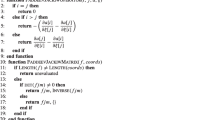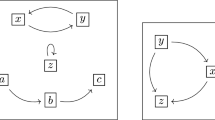Abstract
We promote the Noether charge of the electric–magnetic duality symmetry of U(1) gauge theory, “G”, to a quantum operator. We construct ladder operators, \(D_{(\pm )a}^\dagger (k)\) and \(D_{(\pm )a}(k)\), which create and annihilate the simultaneous quantum eigenstates of the quantum Hamiltonian (or number) and the electric–magnetic duality operators, respectively. Therefore, all the quantum states of the U(1) gauge fields can be expressed in the form of \(|E,g\rangle\), where E is the energy of the state, and g is the eigenvalue of the quantum operator G, where the g is quantized in the unit of 1. We also show that ten independent bilinears comprised of the creation and the annihilation operators can form \(\mathrm{SO}(2,3)\), which is as demonstrated in Dirac’s paper published in 1962. The number operator and the electric–magnetic duality operator are members of the \(\mathrm{SO}(2,3)\) family of generators. We note that there are two more generators that commute with the number operator(or Hamiltonian). We prove that these generators are, indeed, symmetries of the action in U(1) gauge field theory.

Similar content being viewed by others
Notes
It is manifest that the expression of G in terms of the annihilation and the creation operators Eq. (12) does not diverge when \(|k|\rightarrow 0\), where \(\frac{k^a}{|k|}\) is unit vector in the momentum, \(k^a\), direction, which is finite in any case. In the original definition of G given in Eqs. (2), (37) in position and momentum spaces, respectively, they seem to be divergent in that limit. In fact, they are not. In the Lagrangian formulation, the electric field \(\vec {E}^T=\omega \vec {A}^T\) and for a real photon, \(\omega =|k|\). The \(\vec {E}^T\), \(\vec {A}^T\) are the transverse parts of the elecctric and gauge fields, respectively, which are the genuine degrees of freedom. Thus, \(\frac{E^T}{|k|}\) is finite as \(|k|\rightarrow 0\), where \(\omega\) is energy of the photon (see also [17]). One can interpret the operator G as the helicity operator and quantization of its eigenvalues with unit 1 is reasonable in that sense. The original definition of the helicity is given by \(\vec {L} \cdot \frac{\vec {k}}{|k|}\), where the \(\vec {L}\) is angular momentum of the photons. It is a projection of the photon angular momentum, which is finite by definition, along the direction of the propagation [1].
References
M.G. Calkin, Am. J. Phys. 33(11), 958 (1965). https://doi.org/10.1119/1.1971089
C. Bunster, M. Henneaux, Phys. Rev. Lett. 110(1), 011603 (2013). https://doi.org/10.1103/PhysRevLett.110.011603. arXiv:1208.6302 [hep-th]
S. Moon, S.J. Lee, J. Lee, J.H. Oh, J. Korean Phys. Soc. 67(3), 427 (2015). https://doi.org/10.3938/jkps.67.427. arXiv:1405.4934 [hep-th]
S. Deser, C. Teitelboim, Phys. Rev. D 13, 1592 (1976)
S. Deser, J. Phys. A 15, 1053 (1982)
M. Henneaux, C. Teitelboim, Phys. Rev. D 71, 024018 (2005). arXiv:gr-qc/0408101
S. Deser, D. Seminara, Phys. Lett. B 607, 317 (2005). arXiv:hep-th/0411169
S. Deser, A. Waldron, Phys. Rev. D 87, 087702 (2013). arXiv:1301.2238 [hep-th]
S. Deser, D. Seminara, Phys. Rev. D 71, 081502 (2005). arXiv:hep-th/0503030
D.P. Jatkar, J.-H. Oh, JHEP 1208, 077 (2012). arXiv:1203.2106 [hep-th]
I. Fernandez-Corbaton, X. Zambrana-Puyalto, N. Tischler, X. Vidal, M.L. Juan, G. Molina-Terriza, Phys. Rev. Lett. 111(6), 060401 (2013). https://doi.org/10.1103/PhysRevLett.111.060401. arXiv:1206.0868 [physics.optics]
R. Dijkgraaf, (1997). arXiv:hep-th/9703136
E. Witten, Sel. Math. 1, 383 (1995). https://doi.org/10.1007/BF01671570. arXiv:hep-th/9505186
E.P. Verlinde, Nucl. Phys. B 455, 211 (1995). https://doi.org/10.1016/0550-3213(95)00431-Q. arXiv:hep-th/9506011
R.P. Cameron, S.M. Barnett, Electric-magnetic symmetry and Noether’s theorem. New J. Phys. 14, 123019 (2012)
I. Agulló, A. del Río, J. Navarro-Salas, Symmetry 10(12), 763 (2018). https://doi.org/10.3390/sym10120763. arXiv:1812.08211 [gr-qc]
Iwo Bialynicki-Birula, New J. Phys. 16, 113056 (2014). arXiv:1412.2250 [quant-ph]
Acknowledgements
J.H.O thanks his \(\mathcal {W.J.}\) and \(\mathcal {D.D}\). He also thanks Hyun Seok Yang for useful discussions. This work was supported by the National Research Foundation of Korea(NRF) grant funded by the Korea government(MSIP) (No.2016R1C1B1010107) and Research Institute for Natural Sciences, Hanyang University.
Author information
Authors and Affiliations
Corresponding author
Additional information
Publisher's Note
Springer Nature remains neutral with regard to jurisdictional claims in published maps and institutional affiliations.
Appendices
Appendix A: Quantization with the electric–magnetic duality generator and the quantum operators and states
The electric–magnetic duality generator in momentum space is given by
where \(E_a(k)\) are the electric fields and \(A_a(k)\) are the gauge fields. They are a canonical pair and so satisfy the following Poisson bracket relation:
The two fields satisfy the Gauss constraint \(\partial _a E^a=0\) and this ensures that they are transverse fields. Therefore, the Poisson bracket relation can be modified as
where the \(\Pi _{ab}(x)=\left( \delta _{ab}-\frac{\partial _a \partial _b}{\nabla ^2}\right)\) is the project operator.
Quantization Maxwell’s theory is mathematically a collection of two independent harmonic oscillators:
where the indices a, b... are three-dimensional spatial indices and A, B... are the polarization indices. The \(e^a_A(k)\) is the polarization vector, \(e^a_A(k)k_a=0\) to ensure that the fields \(A_a(x)\) and \(E_a(x)\) are transverse and \(e^a_A(k)e^B_a(-k)=\delta ^B_A\). \(p^A(k)=p^A(-k)^\star\), \(q^A(k)=q^A(-k)^\star\) and \(e^A_a(k)=e^A_a(-k)^\star\), because the fields are real. \(e^A_b(k_1)e^a_A(-k_1)\equiv \Pi ^a_b(k_1)=\delta ^a_b-\frac{k_ak_b}{k^2}\).
The Fourier transform
defines the fields in momentum space as
Their Poisson brackets are given by
We define creation and annihilation operators as
and the inverse relations are given by
The final forms of the Poisson bracket are given by
where \({\mathcal {A}}_a(k)=e^A_a(-k) a_A(k)\) and \(\mathcal A^\dagger _a(k)=e^A_a(k) a^\dagger _A(k)\). The quantization of the fields is performed by switching the Poisson brackets to the commutators as \(\{{\ \ }\} \rightarrow -i[{\ \ }]\) and promoting all fields to quantum operators. The forms of the Hamiltonian and electric–magnetic duality operators are given by
and
The annihilation and creation operators are ladders for the Hamiltonian, but those do not increase or decrease the eigenvalues of the operator, G. To find simultaneous ladders for the H and G, we define
Then, the commutation relations can be modified to
Appendix B: Construction of the \([\mathrm{SO}(2,3)]\) group from bilinear operators from \(D_{(\pm )a}(k)\) and \(D^\dagger _{(\pm )a}(k)\)
We start with new definitions of \(D_{(\pm )a}(k)\) and \(D^\dagger _{(\pm )a}(k)\) for further conveience, which are given by
where for \(\xi =\pm 1\), \(D^\dagger _{(\xi )c}(k)\) represents \(D^\dagger _{(\pm )c}(k)\) and for \(\xi ^\prime =\pm 1\), \(D_{(\xi ^\prime )c}(k)\) represents \(D_{(\pm )c}(k)\), respectively. The bilinear operators constructed out of the operators \(D_{(\xi )c}(k)\) and \(D^\dagger _{(\xi )c}(k)\) have the following forms:
where the third and the fourth operators are the same up to a constant(a c-number). Because we are interested in their commutation relations, we regard the third and the fourth operators as the same. One can also classify the operators into their trace, anti-symmetric and traceless-symmetric parts.
First of all, we discuss their trace parts, which are listed below:
and
When \(\xi\) and \(\xi ^\prime\) take the same sign, the bilinear operators Eqs. (58) and (59) become null identically. If they take different signs as equations \((\xi ,\xi ^\prime )=(+1,-1)\) or \((\xi ,\xi ^\prime )=(-1,+1)\), then (58) and (59)are proportional to the trace of the primitive creation and annihilation operators, respectively. Because the operators are not Hermitian, we constitute their appropriate linear combinations to be Hermitian operators. They are nothing but the \(K_2\) and the \(Q_2\) operators listed below.
Only when \(\xi\) and \(\xi ^\prime\) take the same sign, does Eq. (60) become non-trivial and is a linear combination of the number operator and the electric–magnetic duality operator. Together with this, we examine the anti-symmetric parts of the bilinear operators, which are given by
Equations (63) and (64) turns out not to be independent operators. Once we contract the operators with a tensor \(\frac{k_c}{|k|}\epsilon _{abc}\), they become proportional to Eqs. (58) and (59), respectively. The same contractions acting on Eq. (65) leads another linear combination of the number and electric–magnetic duality operators. Therefore, appropriate combinations of Eqs. (65) and (60) provide the operators:
To construct the symmetric parts of the bilinear operators, we utilize the following identities:
Because they are tensor components, they change under \(\mathrm{SO}(3)\) spatial rotation. Therefore, we choose our frame as \(\vec {k}=(0,0,k)\). then, the spatial index a in \(D_{a(\xi )}(k)\) and \(D^\dagger _{a(\xi )}(k)\) can take 1 or 2. All possible (linearly independent of one another) choices are listed below:
Rights and permissions
About this article
Cite this article
Lee, H., Han, SH., Yoon, H. et al. Electric–magnetic duality as a quantum operator and more symmetries of U(1) gauge theory. J. Korean Phys. Soc. 78, 1029–1037 (2021). https://doi.org/10.1007/s40042-021-00179-y
Received:
Revised:
Accepted:
Published:
Issue Date:
DOI: https://doi.org/10.1007/s40042-021-00179-y




